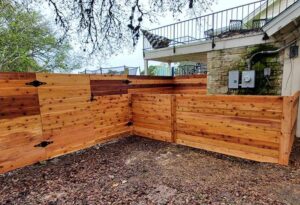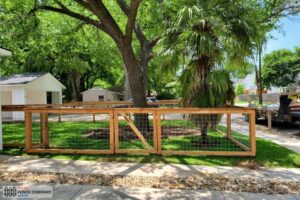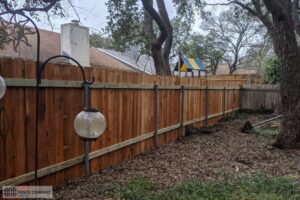Storm Movement vs Rot: How to Tell What Killed Your Fence
A fence usually “dies” in Austin from one of two causes: storm movement (wind surge + shallow/loose posts) or rot (water trapped at the ground line). Storm casualties show sudden, directional lean, cracked collars on the windward side, gate latches that shifted overnight, and panels popped where wind pressure peaked. Rot casualties show mushy wood at the collar, flat concrete “birdbaths,” blackened fastener halos, and a slow year-over-year slump. Quick field tests—post plumb at three heights, collar crowning check, screwdriver probe at the ground line, hinge-barrel alignment, and toe-drainage read—allow you to identify the cause in 15–30 minutes. Repairs follow cause: storms require re-posting to proper embedment, control joints, and wind-calm gates; rot requires draining footings (gravel beds + crowned collars), toe bands, and irrigation fixes. Looking for a professional fence inspection, diagnosis, and a scope that lasts in Central Texas? Begin by working with the local team at Atlas Fence Company.
Table of Contents
ToggleWhat each failure looks like in Austin (storm vs rot)
Storm movement signature

- Overnight change. After a front with gusts, a previously straight stretch now leans one direction (usually away from the wind).
- Continuous lean across multiple posts. If 20–40 ft all tilt together, wind loads the entire sail; the weakest posts move first and pull neighbors.
- Collar fractures on the windward face. Look for crescent cracking or a ring split where the post flexed.
- Gate behavior changed instantly. Latch no longer meets the strike; the leaf closes “short” or rubs on a threshold that was fine yesterday.
- Panel fasteners sheared/pulled. A handful of pickets popped near mid-span on the most exposed section.
Rot signature
- Slow slump. Photos taken six months apart show a gradual lean toward the heavy lawn or flowerbed side.
- Soft wood at the ground line. A screwdriver sinks ¼–½” where the post meets the collar; fibers are dark, stringy, or smell sour.
- Flat concrete collars. Water ponds against wood or steel; algae rings appear.
- Blackened fastener halos. Moisture and tannins stain around screws/nails.
- Green/black toe. Mulch or turf touches boards; irrigation overspray keeps the toe wet.
The 10-minute ground-line inspection anyone can do
Bring: 2-ft level, flat screwdriver, phone, towel, marker; these inspections help in assessing the fence condition .
- Perform a plumb check at three heights on two adjacent posts (12″, 36″, top).
- Storm: Both posts are out in the same direction, with a similar amount.
- Rot: one post worse at the ground line, less out at the top (banana curve).
- Collar top shape
- Pass: dome/crown 1–2″ above grade, sloped away from wood/steel.
- Fail: flat, cupped, or below-grade collar (water traps).
- Screwdriver probe at the post/collar seam
- Pass: firm.
- Fail: blade sinks or flakes; rot confirmed.
- Toe moisture
- Pass: dry, 2–3″ base gap, clean gravel or DG.
- Fail: mulch or soil contacting boards; wet stripe on pickets.
- Panel fasteners
- Storm: pulled heads or split pickets near mid-span.
- Rot: fasteners black/streaked but not sheared.
Snap photos; they’re gold for scoping and, if needed, an HOA claim note.
Rapid tests for posts, panels, and gates
Posts
- Kick test (light) at hip height. If the post springs back, the socket is loose—decide if that’s storm (socket levered) or rot (socket punky).
- Rock probe 6–8″ off the collar. If you “clink” early, you’re on limestone—core-drilling should be in the fix plan.
Panels
- Sail effect read. If one 30–60′ privacy run leans uniformly after a gust front, add hidden control joints next time so wind doesn’t act on one giant billboard.
- Base gap consistency. Gaps near zero = splash wicking & rot risk; uneven gaps in a push-pull pattern = posts moved during wind.
Gates
- Hinge barrel axis. Sight both barrels; they must align. Storm movement often twists one post—barrels go off-axis, latch misses.
- Clearance to threshold. Target ~1″ over a small broomed, pitched pad. If the pad is flat, mud drag looks like “sag,” but it’s drainage.
Reading the site: wind channels, soils, and irrigation

Wind channels: Greenbelts, side-yard alleys, and hill gaps funnel gusts. Expect storm damage to peak on those runs; switch patterns (e.g., shadowbox for airflow) or break spans with control joints.
Soils:
- Expansive clay requires 6–8″ of compacted ¾” rock at hole bottoms and crowned collars. Foam or flat collars can guarantee pump-loosened sockets.
- Shallow limestone: don’t stop shallow—core-drill 8–12″ into competent rock and set with non-shrink grout.
Irrigation: Any head that mists the toe is a rot machine. Redirect or convert to drip along the fence line.
Decision tree: repair the bay, patch the run, or rebuild
If storm movement is primary:
- One or two failed posts? Re-post just the bay(s) to proper embedment (depths below), add control joints if the run is long, and tune the gate.
- Uniform lean across a long run? Re-post a section (every 2–3 posts), add hidden control joints every 24–32′, and install a top cap to stiffen.
If rot is primary:
- Localized mush at the toe? Re-post those bays with gravel beds + crowned collars, cut a 2–3″ base gap, add a DG toe band, and redirect irrigation.
- Is the toe chronically wet along the whole run? Address drainage (swales/downspout extensions) and rebuild the run; otherwise, new posts will join the party.
If both show up (common):
Treat structure first (embedment, collars), then adjust wind behavior (control joints/top caps/airflow pattern). Don’t skip either.
Spec that prevents a repeat (embedment, collars, spans, hardware)
Embedment & holes
- 6′ privacy: 30–36″ embedment in clay; core-drill limestone 8–12″.
- 7–8′ privacy: 36–42″ in clay; larger diameters at corners/gate bays.
- Use 4×6 posts at corners, gates, and step transitions; steel posts at exposed corners if windy.
Draining footings
- 6–8″ compacted clean ¾” rock at hole bottoms (geotextile “burrito” in fat clays).
- Pour from bottom up, rod lightly; finish crowned collars 1–2″ above grade, sloped away from wood/steel.
Spans & wind
- Break long privacy runs with hidden control joints.
- Consider a shadowbox on the worst wind funnel to reduce sail pressure; keep a uniform 2–3″ base gap for pressure bleed.
Hardware & fasteners
- Hot-dip galvanized or exterior-coated fasteners; avoid mixed-metal stacks that accelerate corrosion.
- Through-bolt gate hardware; lags loosen as soils move.
Gate geometry when storms and rot both show up
- Rigid steel frames keep leaves square under wind and humidity.
- Adjustable heavy-duty hinges with barrels aligned on one axis.
- Threshold pad (small, broomed, pitched away from hinges) with ~1″ clearance under the leaf—no mud drag, even after significant rains.
- On broad leaves, add a two-point latch or drop rod in wind channels.
If your current bay already fights you daily, consider rolling the fix into targeted fence repairs in Austin. This way, you can re-post correctly and avoid re-shimming latches every season.
Timeline & cost cues (so you don’t over- or under-scope)

Storm-led, 1–2 bays:
Half to one day: re-post, crown collars, re-hang panels, tune gate, add a discreet control joint.
Rot-led, 1–2 bays:
One day: re-post with gravel beds + crowned collars; cut base gaps; add DG toe band and adjust irrigation.
Mixed + long run:
2–4 days depending on length: re-post on a cadence, control joints every 24–32′, top caps, gate rebuild with threshold pad.
Finish window:
Stain in fall or mild spring; keep irrigation off faces for 48–72 hours.
If you think the whole line is beyond saving and want a clean, durable reset—encompassing spacing, posts, gates, and drainage in one shot—bundle it as a cohesive fence installation plan in Austin to ensure structure and finish align from day one, especially if you are considering a new fence .
To prepare for the next storm, grab the homeowner list here: Storm Fence Checklist (Austin).
FAQs
Hairline shrink cracks that don’t wrap the post are common. If you see a crescent crack on the windward side with visible tilt, that’s structural—storm movement flexed the socket.
Not in Austin’s clays/limestone. Foam doesn’t replace embedment or drainage-friendly collars. Use gravel beds + crowned collars; core-drill limestone.
Thermal movement plus off-axis hinges. Align barrels, tune the strike, and make sure the posts are truly plumb at depth.
Yes—if you also fix the cause (flat collar, mulch/soil contact, irrigation drift). Otherwise, the next post will follow.
You need structural upgrades (embedment, possibly 4×6 or steel at corners) and control joints to stop billboard behavior. Consider airflow patterns in windy corridors.
End the Storm-Rot Fence Cycle
Want a precise diagnosis and a fix for any residential or commercial fence that doesn’t boomerang after the next thunderstorm? We’ll map wind exposure and soils, probe posts, and design draining footings with control joints or toe-drying details to stop the cycle—then repair or rebuild the right way. Book your Austin storm/rot fence diagnosis → or call (512) 366-8108.
